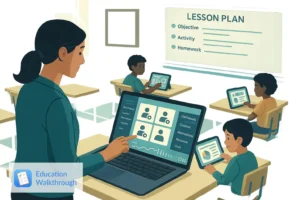Navigating the dynamic world of school administration can be a thrilling yet challenging journey, especially for those just stepping into the role. Often, the early days are filled with introductions, understanding school dynamics, and building rapport with staff and students. But as the first quarter settles down, the pressing question emerges: How can an administrator effectively engage during classroom visits without merely being a silent observer? Teachers eagerly await a more active administrative presence, yet it’s common to feel slightly out of place in the beginning. If you’ve ever wondered whether to join a small group, interact with the students, or observe the teacher, you’re not alone. Dive in as we explore actionable ways to make the most of your classroom visits and foster a positive collaborative environment.
- Step in and Teach: Temporarily take over a lesson, giving teachers a short break. It’s a gesture of support and a way to connect with students.
- Bring Little Treats: A snack or water for the teacher shows care. It can also be an informal way to check in and give teachers a small break.
- Engage in Seasonal Activities: Being hands-on during arts and crafts can be beneficial, especially when more adult supervision is required.
- Impromptu Story Sessions: Carry a book and occasionally read to a class. Ensure teachers are informed in advance to anticipate your visit.
- Positive Affirmations: Encourage students to write positive notes about their teachers and peers. This can uplift the classroom environment.
- Gift of Time: Offer teachers a ‘time coupon’ that allows them a 30-minute break while an admin covers their class.
- Informal Evaluations: During brief visits, assess:
- Student engagement and learning.
- Classroom cleanliness and safety.
- Pace of the class.
- Overall mood of the classroom.
- Learning conditions.
- Teacher’s performance and organization.
- Be a Learner: Actively participate in lessons, engage with students in the context of the lesson, and provide constructive feedback.
- Identify Purpose of Visits: Clearly understand and communicate the objective of classroom visits, whether it’s relationship-building, observing, providing feedback, or assisting.
- Act as an Assistant: Assist in teaching, classroom management, or even in maintaining classroom cleanliness.
- Engage in Coaching: Plan weekly with teachers and occasionally co-teach or handle small groups.
- Seek Teacher Feedback: Use tools like Google forms to get insights from teachers on how you can be more beneficial during visits.
- Mobile Office: Consider having a mobile desk in hallways for accessibility. This provides an avenue for brief conversations and shows your presence.
- Co-Teaching: Collaborate with teachers to deliver lessons, providing a platform for mutual learning.
- Engage with Students: Whether helping with activities, taking notes, or assisting those struggling, be hands-on with the students.
- Observe with Feedback: Ensure every observation is followed by constructive feedback, fostering a growth environment.
- Reading Sessions: Engaging students with picture books or stories, especially ones with social emotional learning themes.
- Emphasize Positives: During the initial phases, focus on recognizing and highlighting the positive aspects of classroom management and teaching.
- Student Interaction: Engage in group activities, ask students about their assignments, learning objectives, and even the standard they’re working on.
- Special Observations: Focus on students who require interventions or are new to the school, ensuring they are integrating well.
- Blend In: The key is to seamlessly integrate into the classroom environment, enhancing the learning process.
- Maintain Open Communication: Keep lines of communication open with both teachers and students, emphasizing your role as a supporter and collaborator.
The overarching theme from these suggestions is the importance of building relationships, understanding the classroom environment, and supporting both teachers and students in the learning process. The administrator’s role is pivotal in setting a positive tone for the educational environment. It’s essential to strike a balance between observation, participation, and active support.





